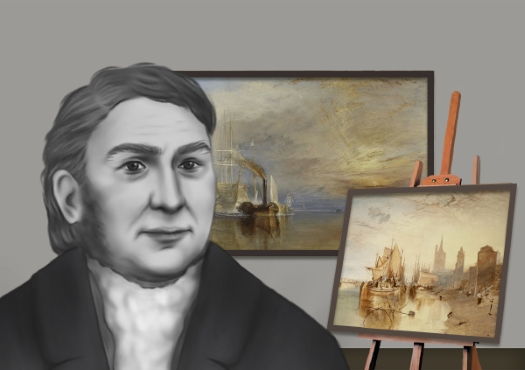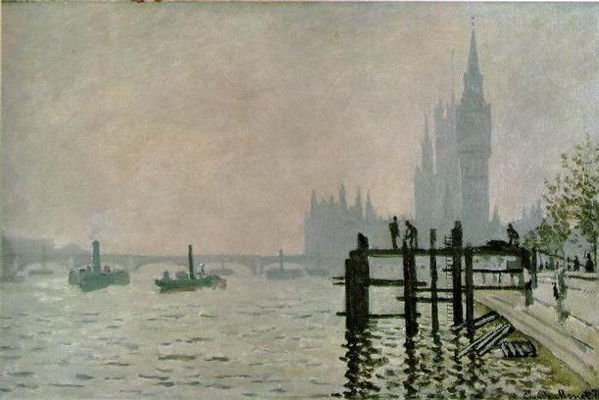Summary of Joseph Mallord William Turner
Turner took classical genres and scenes - the stately landscape in well-designed compositions and historical events writ large - and infused them with a new dynamic in painting. He reflected on the increasing importance of individual experience in the era of the Enlightenment, where the perceptions of human beings led to exalted personal moments and sublime interactions with nature. Through this dedication to rendering heightened states of consciousness and being, he helped define the cross-disciplinary artistic movement of Romanticism, setting the stage for later developments in painting subjective experiences that would lead to Impressionism. In some of his later works especially, Turner responded to the arrival of the modern era by making the contraptions of human invention powerfully, sometimes threateningly present.
Accomplishments
- Striving for greater subjective effects, he ignored and even exploded the precise rendering of details and static scenes that previous generations' masters and his peers still pursued. Instead he developed painterly effects to render perceptions from closely observed nature, resulting in swirling clouds of varied light and bold arrays of color dabbed in oil. Many of these techniques in paint to evoke sensations of the "Sublime" would become the substance and subject matter of the generation of painters working in Abstract Expressionism.
- The subjects chosen for many of his paintings emphasized the power of nature in a way that had not previously been depicted - making the human figure and all that civilization had built seem minuscule and fragile in comparison.
- Turner helped establish landscape painting - and especially its water-based corollary, seascapes - as an artistic genre for greater respect and exploration, compared to what had existed before or during his own time.
- Turner also incorporated novel motifs from the modern industrial era into his paintings - steamships and railway trains figuring prominently - foreshadowing a recurrent fascination with these elements of modern life that would figure in later generations of visual artists - from the Futurists, muralists such as Diego Rivera to contemporary artists such as Matthew Barney.
Important Art by Joseph Mallord William Turner
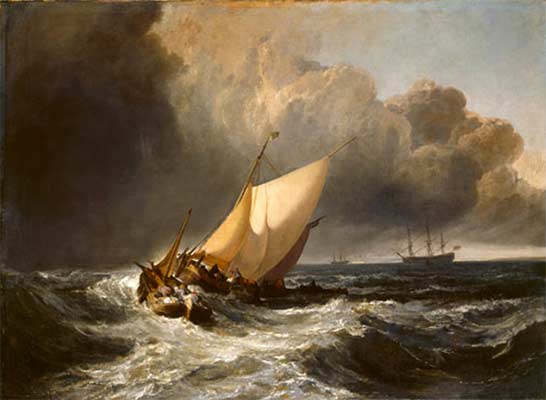
Dutch Boats in a Gale ('The Bridgewater Sea Piece')
Dutch Boats in a Gale was commissioned by the third Duke of Bridgewater as a companion piece for a 17th-century seascape, Ships on a Stormy Sea by Willem van de Velde the Younger. In this painting, Turner shows ominous clouds and a stormy sea with boats struggling on the rough water. In contrast to the companion piece, Turner's boats look doomed to collide, conveying a sense of danger. This piece from 1801 is evidence of the influence of Dutch painters on Turner's early work but already with the sort of turbulence featured in it that became one of Turner's hallmarks.
Oil on Canvas - The National Gallery, London
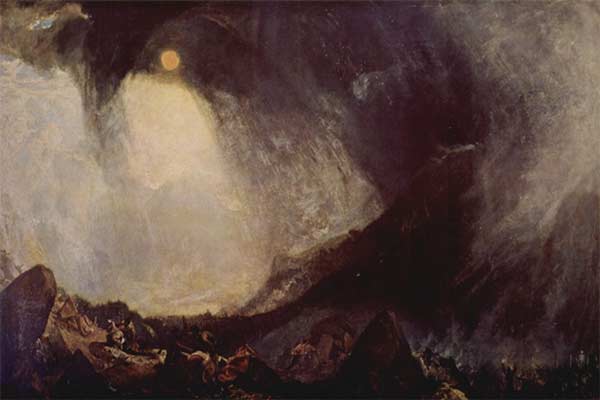
Snow Storm: Hannibal and his Army Crossing the Alps
In this painting, Turner depicts Hannibal's soldiers in their struggle to cross the Alps in 218BC. There is a curved arch of black storm clouds hovering over the soldiers with a golden sun peeking through the grayness. In the foreground, the soldiers are fighting local tribes in the murky darkness, while ahead in the distance the plains of Italy are bathed in sunlight. At the right is an avalanche of snow descending down the mountain. Hannibal's location is not clear, but he may be riding the elephant barely visible in the distance. Turner created this painting during the Napoleonic Wars between Britain and France. He saw parallels between Hannibal and Napoleon, and this painting is his response to Jacques-Louis David's portrait of Napoleon Crossing the Alps (1801-1805). This work is the first painting where Turner uses a swirling vortex of wind, rain, snow and clouds that he returned to often in later works, such as Snow Storm: Steam-Boat off a Harbour's Mouth (1842). His ongoing investigations of light and atmosphere greatly influenced future Impressionists and Post-Impressionists, such as Monet and Pissarro.
Oil on Canvas - Collection of the Tate, United Kingdom
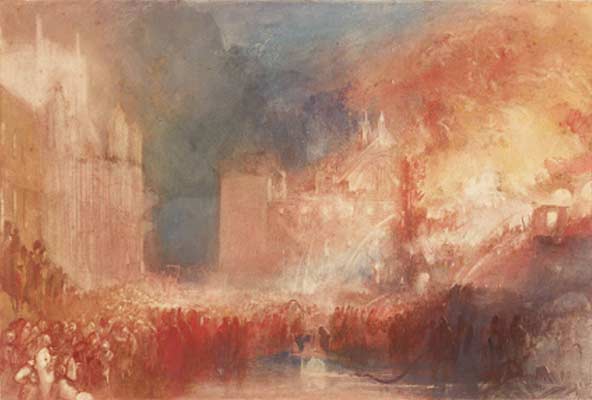
The Burning of the Houses of Parliament
In 1834 a fire engulfed the Houses of Parliament and burned for hours while Londoners watched the horrifying event. Turner made a series of sketches, watercolors, and oil paintings of the spectacle from the viewpoint of the Thames River. This watercolor and gouache on paper shows a closer view of the fire and those gathered to watch. Turner uses color to convey the magnificent light and heat: as much the subject of the painting, as the event of the burning building itself. This favoring of the elemental aspects of the conflagration, as well as the fire itself, embodies one of Turner's favored themes as well: the puniness and ephemerality of man's efforts in the face of nature.
Watercolor and gouache on paper - Collection of the Tate, United Kingdom
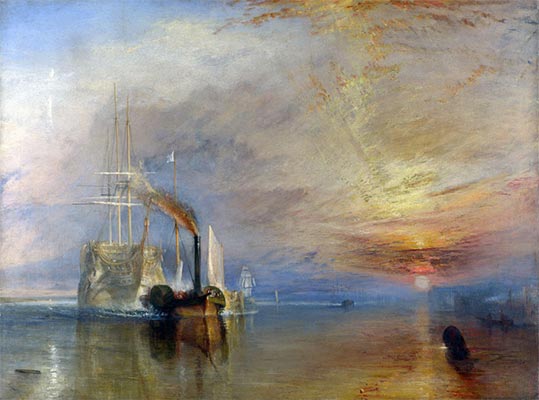
The Fighting Temeraire Tugged To Her Last Berth to Be Broken Up
In The Fighting Temeraire, Turner depicts a once powerful and magnificent warship being towed to its final destination to be broken up for scraps. In the painting, the ship appears like a ghost in the background being towed by a small, dark, steam-powered tugboat. The sails of the other vessels in the background form a triangle within a larger triangle of blue sky. Behind the Temeraire, the sun is setting and the moon casts a beam across the river. This painting symbolizes the end of an era, the end of heroic power, and the advent of the Industrial Revolution. Steam-powered vessels were taking the place of the large sailing vessels of the past. It is suggested that the ship may also symbolize Turner himself as he contemplated his accomplishments of the past, his mortality, and saw new artists being recognized. Turner took some liberties in portraying this event, for example the Temeraire did not have its masts intact when it was towed. He wanted to portray her in her former majestic state and so included them in the painting. His revision of details demonstrated a liberation from "just facts" that was an innovation inspiring future modern painters to feel freer in their interpretations of depicted scenes.
Oil on Canvas - The National Gallery, London
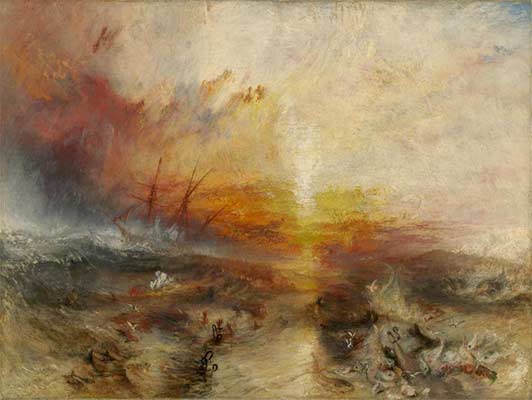
Slave Ship (Slavers Throwing Overboard the Dead and Dying, Typhoon Coming On)
In this painting, Turner shows a ship in the background moving through a tumultuous sea, and in the foreground, in the ship's wake, dark-skinned bodies with chains on their legs, while hovering nearby are fish and sea creatures looking dangerously ready to devour them. Turner based this painting on a poem that described the Zong, a slave ship caught in a typhoon, and the true story of that ship in 1781, when its captain ordered 133 sick and dying slaves thrown overboard so that he could collect the insurance money. Turner timed the exhibition of this painting to coincide with the meeting of the British Anti-Slavery Society. Although the British Empire had outlawed slavery in 1833, Turner believed slavery should be outlawed throughout the world, and his hope was that Prince Albert would be moved to increase anti-slavery efforts when he viewed the painting. Alongside the painting, Turner displayed lines from his unfinished poem, "Fallacies of Hope":
"Aloft all hands, strike the top-masts and belay;
Yon angry setting sun and fierce-edged clouds
Declare the Typhon's coming.
Before it sweeps your decks, throw overboard
The dead and dying - ne'er heed their chains
Hope, Hope, fallacious Hope!
Where is thy market now?"
John Ruskin, the first owner of Slave Ship, wrote, "If I were reduced to rest Turner's immortality upon any single work, I should choose this."
Oil on Canvas - Museum of Fine Arts, Boston
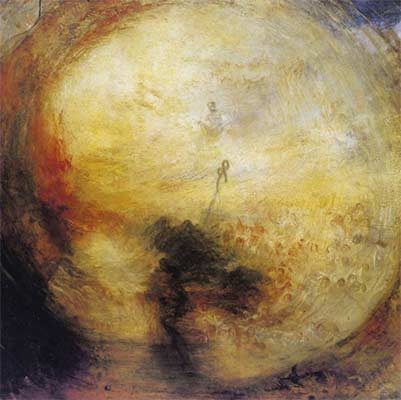
Light and Color (Goethe's Theory) - the Morning after the Deluge - Moses Writing the Book of Genesis
The unusual square shape of this late painting, with even dimensions on all sides, indicates neither the conventional orientation for the genre of either landscape or portraiture, further channeling the subjective experience by focusing the viewer's gaze into the center of a sort of elemental vortex. The primary figures - Moses and a serpent - are represented hazily amid the sort of seemingly formless fields of color and light that critics who were contemporaries of Turner often objected to in his later works. Meanwhile the relative brightness of Turner's palette in this moody work hints at darker aspects that might be apprehended from the Biblical story of redemption after the trial of the flood. This is associated with the sub-title of the piece - where the potential feeling of triumph or relief for those who survive such catastrophes is mixed with an awareness that the same dark forces may produce a new crisis at any time in the future. Turner uses his own treatment of the phenomenon of color and light to represent a version of the Biblical tale as seen through a perceptual filter related to Goethe's psychological and philosophical account of the way humans actually experience color as a phenomenon. Through this combination Turner furthers a Romantic update of both the classical Bible story and the work of Goethe - another exemplar of latter day Classicism and prototypical instigator of Romantic notions - in the generation leading up to Turner's own time.
Oil on Canvas - Collection of the Tate, United Kingdom
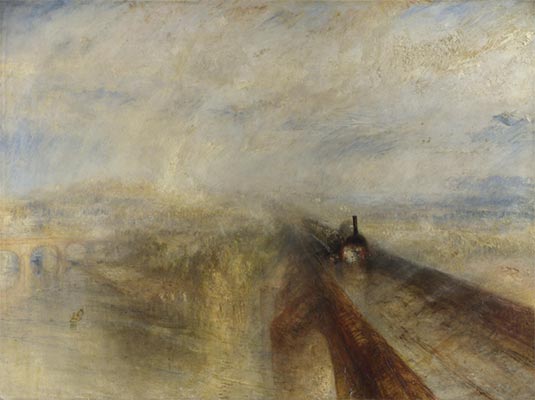
Rain, Steam and Speed - The Great Western Railway
This painting depicts a steam-powered train speeding across a modern bridge away from London. In the distance is an older bridge and in the lower right is a small hare. Some suggest that the hare is not only one of nature's symbols of speed, but that Turner is warning us of the dangers of technology destroying nature in its race toward progress. The only highly detailed section in the painting is the smoke stack of the train, showing Turner's ability to create provocative paintings with very little detail.
Oil on Canvas - The National Gallery, London
Biography of Joseph Mallord William Turner
Childhood and Education
Joseph Mallord William Turner's actual birthdate is unconfirmed, but he was baptized on May 14, 1775. His father, William Turner was a barber and wig maker and his mother, Mary Marshall, came from a family of butchers. His younger sister, Mary Ann, was born in September 1778, but died when she was 5 years old.
At the age of ten, due to his mother's signs of mental instability, Turner was sent to live with an uncle in Brentford, Middlesex, a small town on the banks of the Thames, to the west of London. In Brentford, Turner began his artistic activities by coloring a series of engraved plates. Later, in 1786, he was sent to Margate where he attended school and also began to draw the town and surrounding area. Back in London, his father exhibited these drawings in his shop and sold them for a few shillings each. Sketching the town and countryside and later creating finished paintings from location sketches would become his working style throughout his career. Although he lived in different areas around London and later traveled widely, he remained a Londoner throughout his life and never lost his Cockney accent. Unlike many of his contemporaries, Turner did not adopt an elitist air as he climbed the professional ladder. In contrast, John Constable famously jockeyed for position in terms of social status and by literally contriving to displace a Turner painting in one exhibition at the Royal Academy with one of his own. Though Turner spent time in the society of noble patrons, he preferred to frequent his humbler residences in Chelsea and the fishing village of Margate, even later in life, while also sojourning ceaselessly in the country and seaside in pursuit of striking subjects out in the natural world.
Early Period
Early in Turner's career, he created architectural studies for several architects and later worked with a topographical draughtsman. As a result, many of his early drawings and watercolors included architectural subjects. At the age of 14, he entered the prestigious Royal Academy of Art, and was accepted as an Academy member a year later. Founded by an act of King George III in 1768, the Academy was an important broker of taste as well as a crucial node in the network of possible sales and commissioning - especially from the Royal Family and nobility - for its artist members. Although he was interested in architecture, he was advised by the architect Thomas Hardwick to continue painting. During this period, Turner produced watercolors that were exhibited every year at the Academy. His routine was to paint in the winter and travel in the summer throughout England and Wales. In 1796, he exhibited his first oil painting, Fishermen at Sea at the Royal Academy. It was a nocturnal moonlit scene, the type of nighttime painting that was popular at the time. He was praised for this piece, and it established him as both an oil painter and a portrayer of maritime scenes.
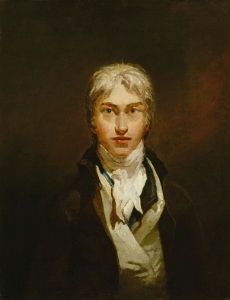
In 1799, at the age of 24, Turner was elected an associate of the Royal Academy. At this time, he painted a flattering self-portrait, indicating his belief that he had "arrived." In 1802 he became a full academician. Further recognition came in 1807, at the age of 32, when he was appointed professor of perspective. By 1800, he was already financially prosperous and moved to a better address in London, Harley Street, where he shared a flat with J.T. Serres, an older marine painter. In 1804, he opened a gallery on Harley and Queen Anne Street to exhibit his work.
He expanded his travels to the European continent in 1802, visiting France and Switzerland. A group of noblemen sponsored this trip, and he was provided with a French-speaking guide and a small coach. He documented the trip with his painting, Calais Pier (1802-3) and made more than 400 drawings during this journey.
Mature Period
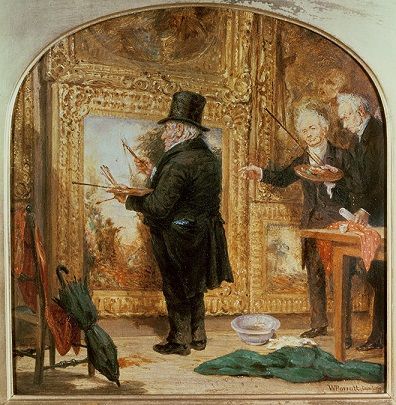
In his early paintings Turner attempted to master other styles he admired, such as the realistic, orderly pictorial techniques of Willem van der Velde and Claude Lorrain, but by 1805 his oil sketches and paintings such as The Shipwreck demonstrated his own original approach to landscapes and seascapes. By his late 30s, his work became increasingly atmospheric and luminous. In paintings such as Snowstorm: Hannibal and his Army Crossing the Alps (1812), he started to focus his efforts on portraying the power of nature and man's insignificance in the face of it, while creating a historical rendering. In addition to painting, Turner was interested in poetry, especially Walter Scott, Lord Byron, Thomas Moore and John Milton, and he wrote his own poetry as well, including an unfinished and unpublished work, Fallacies of Hope, in 1812. Much later, when Turner exhibited Slave Ship (Slavers Throwing Overboard the Dead and Dying, Typhoon Coming On) (1840) at the Royal Academy, he included excerpts of his poetry alongside the painting.
With the end of the Napoleonic Wars in 1815, Turner was able to travel abroad again. In the summer of 1819, he made his first trip to Italy, visiting Rome, Naples, Florence, and Venice. During this time, he made about 1,500 drawings from which he developed several paintings. These paintings, such as The Grand Canal, Venice (1835) show a change in how he used color - with many transparent layers, warm and cool colors creating form, and, more generally, a bolder range.
Turner was very private about his personal life, and he became more eccentric as he grew older. He had few close friends, but was very close with his father who lived with him for 30 years and worked as his studio assistant, cook and gardener. His mother had died in 1804, probably in the mental hospital in Bethlem. After his father died in 1829, Turner suffered bouts of depression. Although he never married, he had two daughters, Eveline and Georgianna, with an older widow, Sarah Danby. Turner wrote in one of his sketchbooks that "Woman is doubtful love" and there is some evidence that the actual mother of his daughters was Sarah Danby's niece who was his housekeeper for a period of time. Later, he had a relationship with Sophia Caroline Booth, living as 'Mr. Booth' in her house in Chelsea.
Late Period
Turner continued to travel in his later years, visiting Italy, Switzerland, Germany, France, Denmark and Czechoslovakia. He sketched tirelessly, and his bequest included approximately 19,000 sketches from these travels. His paintings became more fluid and atmospheric with minimal details. Some examples during this period include The Fighting Temeraire tugged to her last berth to be broken up (1839) and Rain, Steam, and Speed - the Great Western Railway (1844). These paintings expressed Turner's response to the changes being introduced by the Industrial Revolution. Turner's innovative style in these later paintings was criticized publicly, and John Ruskin, an English art critic and long-time supporter of Turner's work, defended him by publishing Modern Painters (1843-60). Turner exhibited at the Royal Academy for the last time in 1850.
The Legacy of Joseph Mallord William Turner
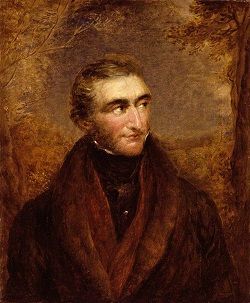
Turner died in Cheyne Walk in Chelsea on December 19, 1851, and he is buried in St. Paul's Cathedral. He left most of his fortune to found a charity for "decayed artists," and he bequeathed his finished paintings to the National Gallery. As a result of litigation by relatives much of the fortune was inherited by them and both the finished and unfinished paintings became national property as a group under the name The Turner Bequest. Most of Turner's paintings are now housed in the Tate Britain with several important works held by the National Gallery. In 1984, the Tate Britain created the prestigious Turner Prize art award, and in 2005, Turner's The Fighting Temeraire was voted Britain's "greatest painting" in a BBC public poll.
Among painters, Turner's impact has been felt for more than two centuries now: his representation of the confrontation humans experienced upon encountering the effects of their own machine inventions in the modern era was an early attempt to engage with the world-changing Industrial Revolution. Even more influential was his mode of representation: impressionistic renderings of the effects of nature that expressed inner psychological states to the point of extreme, extraordinarily early abstraction - to a degree that would only be engaged with again as fully by painters more than a century later.
Turner's work, especially his late work, was deeply admired by the abstract painter Mark Rothko. One can see the influence in Rothko's large canvases of subtly shifting layers of color. In 1966 when Rothko saw an exhibition of Turners in a show sub-titled Imagination and Reality at the Museum of Modern Art in New York, he was quoted as saying, "This guy Turner, he learnt a lot from me." The radical nature of Turner's engagement with issues that were not only ahead of its time but still relevant in the contemporary moment was shown by this rare embrace of the work of a pre-modern master by a museum dedicated to modern art. In 2009, the Tate Britain displayed a selection of Turners in a room opposite another dedicated to six Rothko paintings, allowing visitors to compare the "striking affinity" between the two artists' work.
Furthermore, Turner's investigations of color and light inspired the contemporary Danish-Icelandic artist Olafur Eliasson to create a series of color experiments, each inspired by a different Turner painting. Eliasson states, "I have carefully dissected the amount of color tones, darkness and brightness in a group of Turner paintings, and then made a kind of 'color chart portrait' of each one, using the exact same colors and amount of light and darkness."
Influences and Connections

-
![Claude Lorrain]() Claude Lorrain
Claude Lorrain -
![Nicolas Poussin]() Nicolas Poussin
Nicolas Poussin -
![Thomas Gainsborough]() Thomas Gainsborough
Thomas Gainsborough ![Willem van de Velde]() Willem van de Velde
Willem van de Velde
![John Leicester]() John Leicester
John Leicester
 Ask The Art Story AI
Ask The Art Story AI